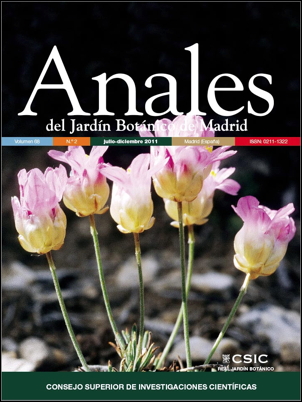Las labiadas (Lamiaceae) de Guinea Ecuatorial
DOI:
https://doi.org/10.3989/ajbm.2288Palabras clave:
Lamiaceae, Guinea Ecuatorial, Bioko, Río Muni, Annobón, distribución, biogeografíaResumen
Se estudian e identifican 223 colecciones de plantas vasculares que corresponden a 14 géneros y 28 especies pertenecientes a la familia Lamiaceae procedentes de las islas de Bioko, Annobón y Río Muni (Guinea Ecuatorial continental). Se incluye una clave de géneros y en cada género, si ha lugar, clave de especies. Se citan de cada especie su basiónimo y material tipo, se incluyen una breve descripción y números cromosomáticos, área de distribución y usos populares conocidos. Se aportan fotografías de pliegos y mapas de distribución. Se discuten aspectos bio - geográficos dentro de la distribución genérica y específica en el área estudiada. Se propone la combinación Calaminta pseudosimensis (Brenan) R. Morales, comb. nov.
Descargas
Citas
Aedo, C., Morales, R., Tellería, M.T. & Velayos, M. (eds.). 2001. Botánica y botánicos en Guinea Ecuatorial. Real Jardín Botánico, CSIC & AECI. Madrid.
Bruce, E.A. 1940. LX.- The genus Pycnostachys. Kew Bulletin of miscellaneous information 1939(10): 563- 593 [463-493].
Cheek, M., Pollard, B.J., Darbyshire, I., Onana, J.M. & Wild, C. 2004. The plants of Kupe, Mwanenguba and the Bakossi Mountains, Cameroon. A conservation checklist. Royal Botanic Gardens Kew.
Exell, A.W. 1944. Catalogue of the vascular plants of S. Tomé (with Principe and Annobon). British Museum. London.
Exell, A.W. 1956. Supplement to the catalogue of the vascular plants of S. Tomé (with Principe and Annobon). British Museum. London.
Exell, A.W. 1973. Angiosperms of the islands of the Gulf of Guinea (Fernando Poo, Príncipe, S. Tomé and Annobon). Bulletin of the British Museum. (Natural History) Botany 4(8): 325-411.
Gómez, E. & Merino, L. 1990. Plantas medicinales de Guinea Ecuatorial. Centro Cultural Hispano-Guineano Ediciones.
Gómez, E. & Merino, L. 2001. Usos de las plantas medicinales en Guinea Ecuatorial. In: Aedo, C., Morales, R., Tellería, M.T. & Velayos, M. (eds.), Botánica y botánicos en Guinea Ecuatorial: 91-131. Madrid. Guinea, E. 1946. Ensayo geobotánico de la Guinea Continental Española. Dirección General de Marruecos y Colonias. Madrid. Guinea, E. 1949. En el país de los Bubis. Instituto de Estudios Africanos. Madrid.
Li, H. 1988. Taxonomic review of Isodon (Labiatae). Journal of the Arnold Arboretum 69(4): 289-400.
Harley, R.M., Atkins, S., Budantsev, A.L., Cantino, P.D., Conn, B.J., Grayer, R., Harley, M.M., De Kok, R., Krestovskaja, T., Morales, R., Paton, A.J., Ryding, O. & Upson, T. 2004. Labiatae. In: Kadereit, J.W. (ed.)& Kubitzki, K. (ed. in chief), The Families and Genera of Vascular Plants VII. Flowering Plants. Dicotyledons: Lamiales (except Acanthaceae including Avicenniaceae): 167-275. Springer. Berlin.
Harvey, Y.B. 1996. The Stachys aculeolata / aethiopica complex in tropical Africa. Kew Bulletin 51(3): 433-454. http://dx.doi.org/10.2307/4117023
Hooker, J.D. 1862. On the vegetation of the Clarence Peak, Fernando Poo; with descriptions of the plants collected by Mr. Gustav Mann on the higher parts of this mountain. Journal Proc. of the Linnean Society, Botany 6: 1-23.
Mildbraed, J. 1922. Wissenschaftliche Ergebnisse der zweiten deutschen Zentral-Afrika-Expedition 1910-1911. Band II: Botanik. Verlag von Klinkhardt & Biermann. Leipzig.
Morales, R. 1990. Micromeria punctata Bentham, novedad para Guinea Ecuatorial, en la isla de Bioco. Anales del Jardín Botánico de Madrid 48(1): 90-91.
Morales, R. 1993. Lamiaceae Guineae Aequatoriales nonnullae. Fontqueria 36: 278-291.
Morales, R. 1994. Lamiaceae Guineae Aequatoriales nonnullae, II. Fontqueria 39: 13-16.
Morales, R. 2001. Utilización de recursos y agronomía en Guinea Ecuatorial. Aspectos históricos. In: Aedo, C., Morales, R., Tellería, M.T. & Velayos, M. (eds.), Botánica y botánicos en Guinea Ecuatorial: 51-75. Madrid.
Morton, J.K. 1962. Cytogenetic studies on the West African Labiatae. Journal of the Linnean Society, Botany 58: 231-283.
Morton, J.K. 1963. 162. Labiatae. In: Hutchinson, J., Dalziel, M. & Hep per, F.N. (eds.), Flora of West Tropical Africa 2, ed. 2: 450-473.
Nosti Nava, J. 1955. La agricultura en Guinea Ecuatorial. I.- La planta. Dirección General de Marruecos y Colonias. Madrid.
Parmentier, I. & Nguema, N. 2001. La vegetación de los inselbergs de Río Muni. In: Aedo, C., Morales, R., Tellería, M.T. & Velayos, M. (eds.), Botánica y botánicos en Guinea Ecuatorial: 201-230. Madrid.
Paton, A. 1992. A synopsis of Ocimum L. (Labiatae) in Africa. Kew Bulletin 47(3): 403-435. http://dx.doi.org/10.2307/4110571
Pollard, B.J. 2005. Two new names in African Plectranthus (Labiatae). Kew Bulletin 60(1): 145-147.
Pollard, B.J. & Paton, A. 2001. A new rheophytic species of Plectranthus L’Hér. (Labiatae) from the Gulf of Guinea. Kew Bulletin 56: 975-982. http://dx.doi.org/10.2307/4119309
Pollard, B. J., Parmentier, I. & Paton, A. 2006. Plectranthus inselbergi (Lamiaceae) a new species from Equatorial Guinea (Rio Muni) and Gabon, with notes on other Central and West African species of Plectranthus. Kew Bulletin 61: 225-230.
Ryding, O. 2007. Revision of the Micromeria (Labiatae) in tropical to southern Africa and on the Arabian Peninsula. Botanical Journal of the Linnean Society 155(3): 427-446. http://dx.doi.org/10.1111/j.1095-8339.2007.00702.x
Sebsebe Demissew & Harley, M.M. 1992. Trichome, seed surface and pollen characters in Stachys (Lamioideae; Labiatae) in Tropical Africa. In: Harley, R.M. & Reynolds, T. (eds.), Advances in Labiate Science: 149-166. Royal Botanic Gardens, Kew.
Seybold, S. 1988. Die Arten der Gattung Satureja L. (Labiatae) in Äthiopien. Stuttgarter Beiträge zur Naturkunde, Serie A, Biologie, 421: 1-38.
Sosef, M.S.M. & al. 2006. Check-list des plantes vasculaires du Gabon. Scripta Botanica Belgica 35.
Descargas
Publicado
Cómo citar
Número
Sección
Licencia
Derechos de autor 2011 Consejo Superior de Investigaciones Científicas (CSIC)

Esta obra está bajo una licencia internacional Creative Commons Atribución 4.0.
© CSIC. Los originales publicados en las ediciones impresa y electrónica de esta Revista son propiedad del Consejo Superior de Investigaciones Científicas, siendo necesario citar la procedencia en cualquier reproducción parcial o total.
Salvo indicación contraria, todos los contenidos de la edición electrónica se distribuyen bajo una licencia de uso y distribución “Creative Commons Reconocimiento 4.0 Internacional ” (CC BY 4.0). Consulte la versión informativa y el texto legal de la licencia. Esta circunstancia ha de hacerse constar expresamente de esta forma cuando sea necesario.
No se autoriza el depósito en repositorios, páginas web personales o similares de cualquier otra versión distinta a la publicada por el editor.















